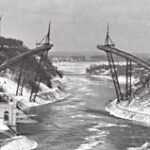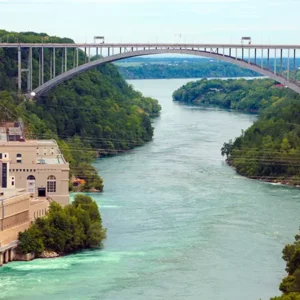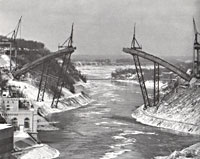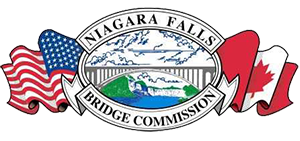What is the NFBC?
A Unique Bi-National Commission
April Jeffs
Established to finance, construct and operate the Rainbow Bridge, the Commission proved sufficiently efficient and effective to be granted responsibilities for the Whirlpool Rapids (Lower) and Lewiston-Queenston Bridges. At our own expense, we build and maintain facilities for Customs and Immigration functions on both sides of the border. The NFBC is self-supportive, largely through user fees (tolls) and private-sector tenant leases. NFBC conducts international commercial financial transactions and issues federal (U.S.) tax-exempt bonds.
A partner in civic and economic development
Niagara Falls’ reputation as a natural world wonder and honeymoon capital of the planet beckons visitors from around the globe.
But it is the bridges that actually bring most of them here.
No other single factor contributes more to tourism growth – indeed the export trade economy overall – than the NFBC’s three monumental linkages of concrete and steel. Niagara Falls crossings are one of the busiest ports of entry between the U.S. and Canada.
A substantial amount of trade traverses the U.S.-Canada border and a significant number of jobs depend on export traffic traveling across NFBC connectors.
Whirlpool Then and Now
A modest kite string spawned the NFBC’s family of three magnificent engineering feats.
Homan Walsh was the first to connect opposite sides of the gorge when — in 1848 — he fastened kite string between the two cliffs.
Thus began the Niagara Falls Suspension Bridge, an oak-plank roadway dangling from iron cables that probably wasn’t a first destination with faint-hearted travelers.
Trains whistled across the Whirlpool Rapids for the first time in 1855 when a second bridge was constructed on the same site. Locomotive traffic continued uninterrupted even in 1897 when the Whirlpool Bridge was rebuilt in the configuration you now see.
Today the Whirlpool Bridge is a dedicated commuter crossing under the NEXUS pre-authorized entry program, expediting clearance through Customs.
It also is a potential candidate for further expansion – redecking to accommodate truck as well as train traffic, thus distributing commercial traffic more equitably along the Niagara Frontier, defined as that region from Buffalo-Fort Erie through Niagara Falls to Lewiston-Queenston.
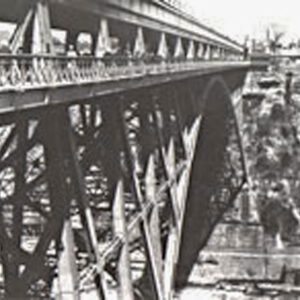
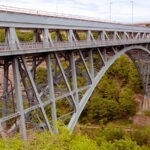
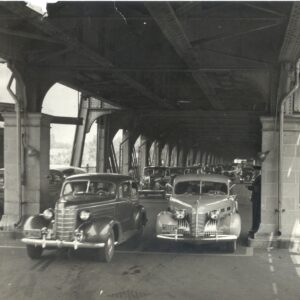
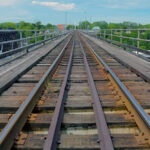

Rainbow Then and Now
Characteristically ahead of its time, the NFBC had begun planning and designing a new span when, in January 1938, the Falls View Bridge crashed into the river under the tonnage of its own ice accumulation.
Britain’s King George VI and Queen Elizabeth dedicated the site of its replacement –the world-renown, world-class Rainbow Bridge – the following year. A commemorative monument at the Canadian Rainbow Plaza is prominent among Niagara historic photo opportunities. Snapshot sites abound around the plaza. Oakes Garden Theatre and Rainbow Gardens, extolled as among the world’s most beautiful, lie adjacent to the Canadian terminal.
Dedication of the Canadian Rainbow Plaza in October 2000 marked the near-completion of a $100-million (U.S.) revitalization and expansion project to meet projected cross-border transportation needs well into this millennium. Our expanded American Rainbow Plaza, dedicated in 1998, won the coveted Federal Design Achievement Award and was a contender for the Presidential Design Achievement Award.
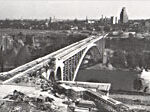
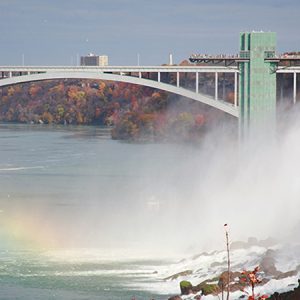
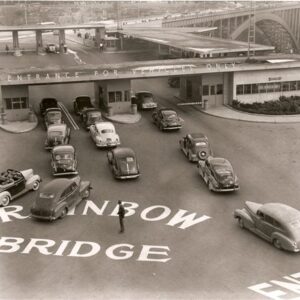
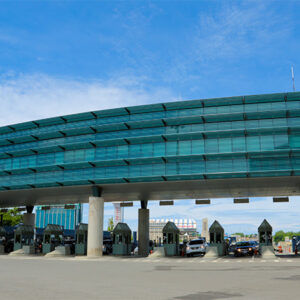
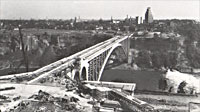
Lewiston-Queenston Then and Now
Here, 370 feet above swirling waters, is the world’s longest hingeless steel arch bridge, stretching 1,600 feet from abutment to abutment (in the bank). Imagine the adventure of river crossing on the old L-Q, a suspension bridge located 7/10s of a mile north. That bridge was built in 1899 on the site of an older suspension span constructed in 1851 and destroyed in 1864.
Built at a cost of $16 million and opened in 1962, the Lewiston-Queenston Bridge connects the picturesque heritage villages of Lewiston, New York and Queenston, Ontario in the Town of Niagara-on-the-Lake. In 2005, $45 million was invested in the bridge to expand it from four fixed lanes to five reversible lanes, allowing traffic across the span to be configured according to whichever direction has the heaviest volume.
Spectacular in any era is the sweeping view this bridge affords of Niagara’s emerald and aquamarine-toned river, precedent-setting electrical power structures, and rich vineyards and orchards. All three NFBC bridges are high-level connectors providing different but equally breath-taking vistas across the gorge.
